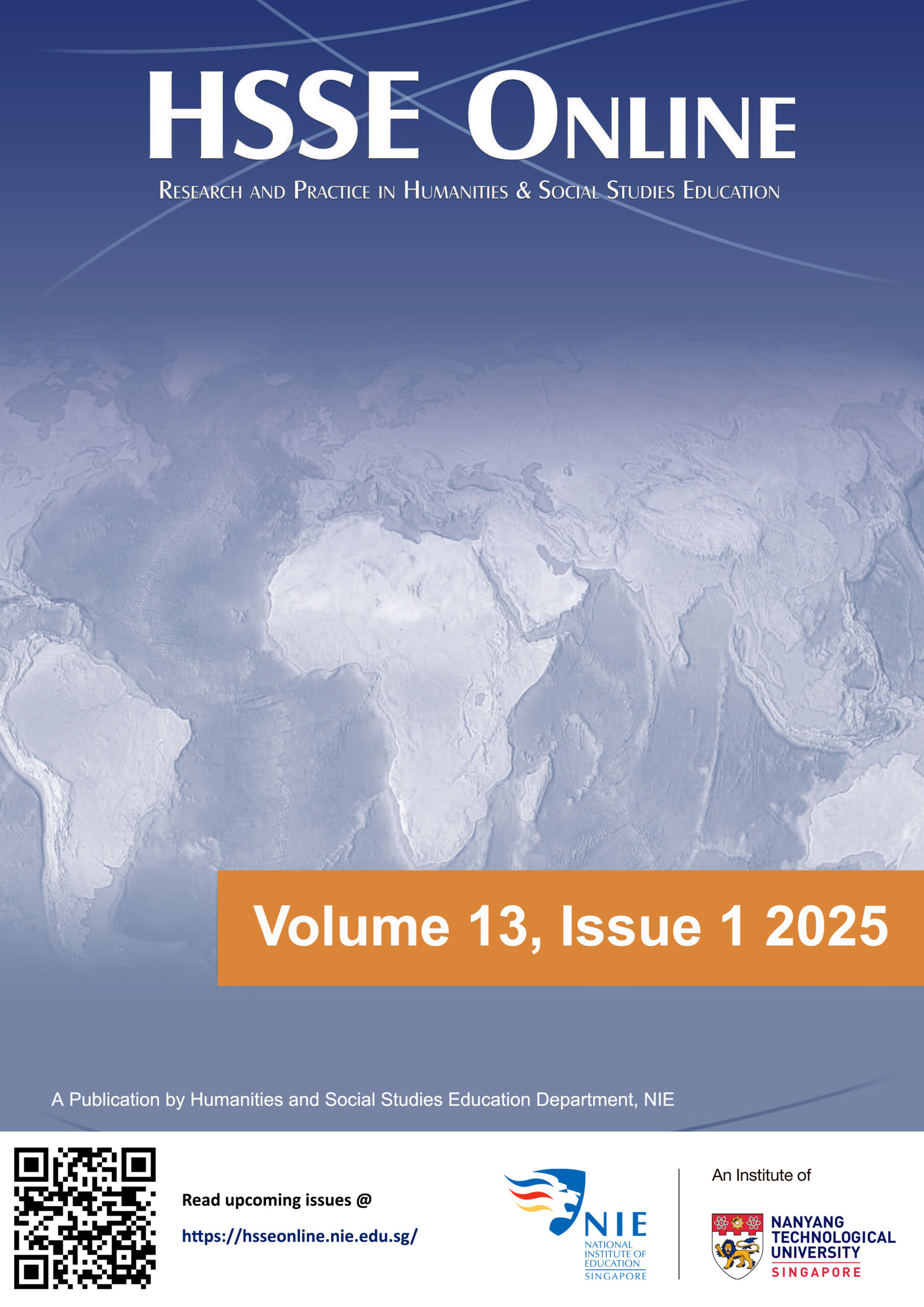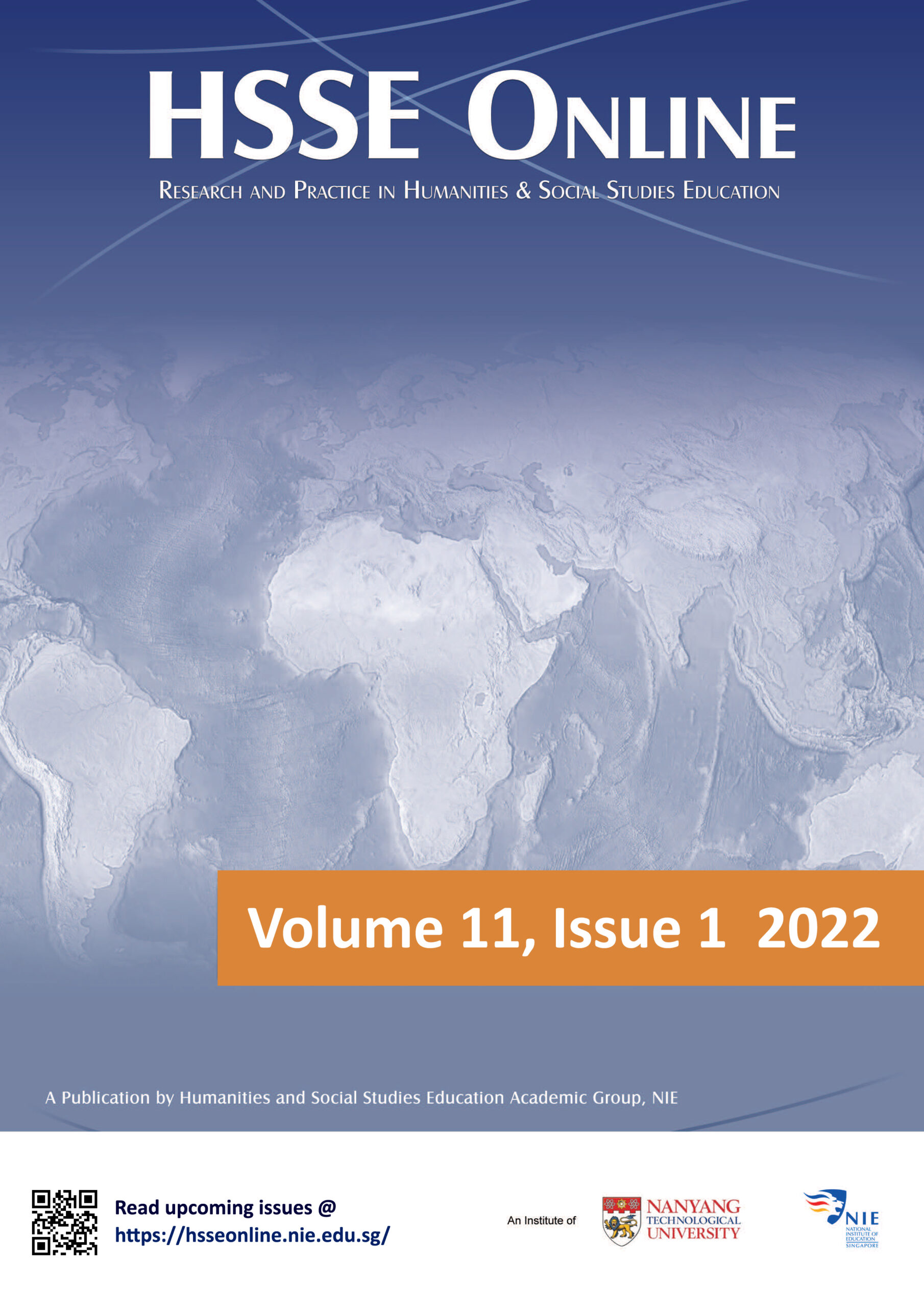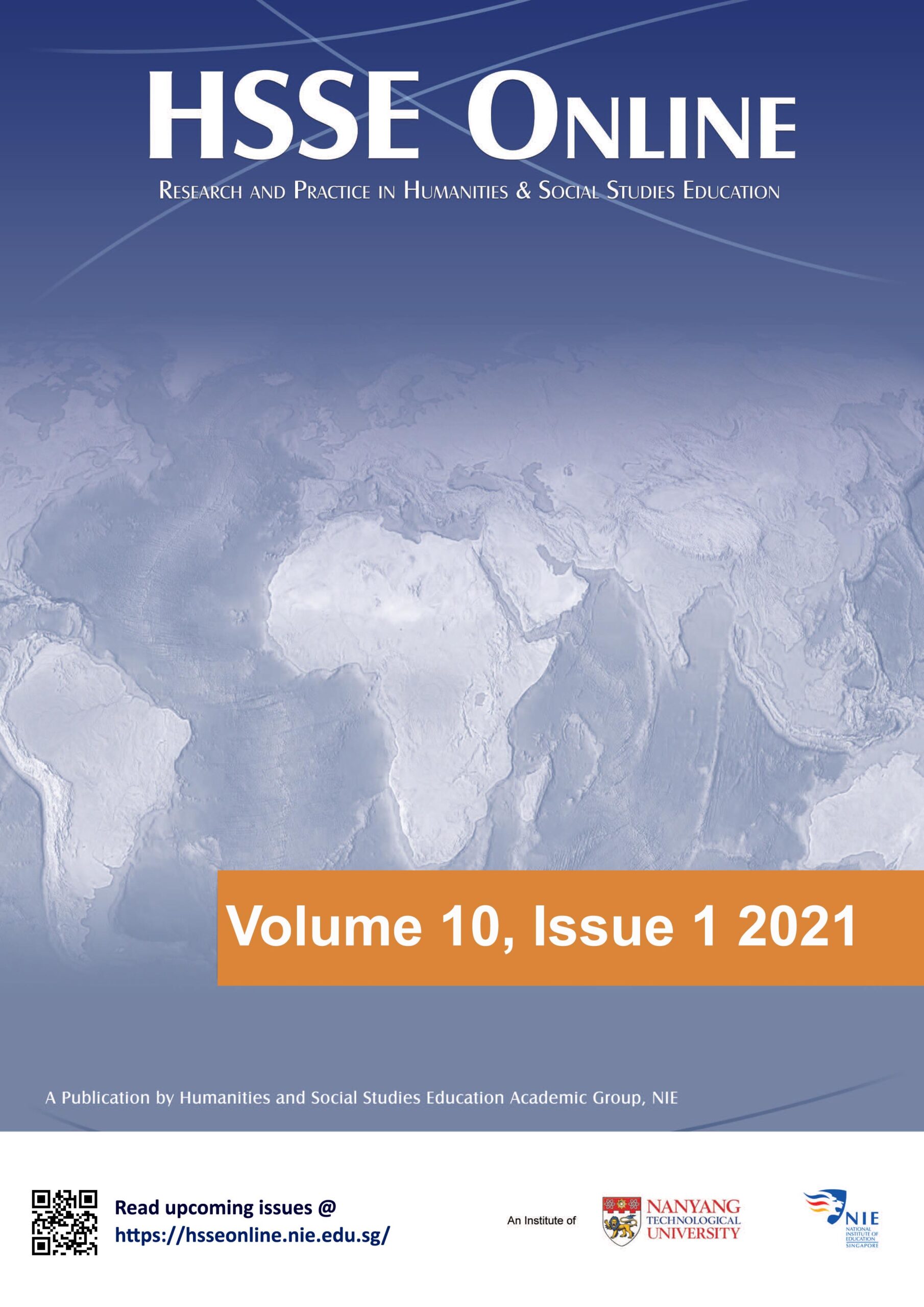Past Issues

Editorial: Reimagining History Education for a Changing World
This volume explores, in various ways, the ongoing relationship between the discipline of history and the school curriculum. While school history is not intended to fully replicate the academic discipline—and students are not expected to become professional historians—the enduring question of “what should school history look like?” continues to drive reflection and discussion among history educators, experienced practitioners, and pre-service teachers.
In this issue, we bring together contributions that address two related themes: (a) how history learning can be made more substantive and enduring, and (b) how curriculum goals can be actualised effectively in the history classroom. What connects these discussions is a shared commitment to a vision of history education that not only prepares students to do well in school but also to develop habits of mind to think critically about the past, reason with evidence, and engage thoughtfully with the world beyond the classroom.
Taken as a whole, the papers in this volume reflect the belief that school history must not only cultivate disciplinary thinking but also be positioned to respond to a rapidly changing social and technological landscape. Across the diverse perspectives and pedagogical approaches proposed by the authors, a common thread emerged: that history education must empower students with the knowledge, skills, and dispositions that can enable them to thrive and remain relevant in an ever-changing, complex, and information-rich future.
Responding to the first theme, Suhaimi Afandi and Edward Tan examine how historical knowledge can be made more “powerful” for students, enabling those who possess it to act within and beyond the discipline. Drawing from conversations among colleagues at NIE and UCL IoE, they explore an approach to lesson design grounded in the idea of ‘powerful knowledge’, where students develop deep historical understanding through conceptually rich, socially relevant learning experiences that extend beyond formal assessment.
Mathew Lim’s paper extends this conversation by considering how artificial intelligence (AI) is reshaping the information landscape that students encounter. His work highlights how history education can prepare learners to navigate AI-influenced realities, while also showing how AI might enhance historical inquiry and students’ engagement with history and the past.
In the following paper, Candice Yvette Seet and her team of teacher-collaborators shift the focus to the power of conceptual teaching in the history classroom. Their paper positions concepts as a vital organising framework in curriculum and instruction, promoting student agency and supporting the development of critical and adaptive thinking—key capacities for learners facing the challenges of an uncertain and fast-changing future.
Turning to classroom experience, Edward Tan and Suhaimi Afandi revisit the theme of lesson design by advocating for the role of ‘play’ in promoting engagement and deep learning. Drawing on their interactions with history student teachers at NIE, they suggest using lesson planning activities (through the Playwheel) to foster playful dispositions amongst pre-service teachers and allow them to reimagine ‘playful learning’ as a legitimate, engaging, and effective pedagogical approach.
The next paper by Gavin Swee further examines how current attitudes towards history learning can be reframed, by addressing the teaching of historical writing, an often underexplored area. He proposes a process-oriented approach that conscientiously supports students in developing historical argumentation and reasoning skills, thereby strengthening their capacity to cultivate disciplinary thinking and writing aligned with historical inquiry.
The second half of the volume turns to technology-mediated lesson designs that can help develop students’ thinking and reasoning in history. Student teachers – Kenneth Kway, Warren Ong, and Andrew Tan – discuss how platforms like Canva open up collaborative learning opportunities, exposing learners to new learning experiences and enabling them to co-construct understanding in dynamic ways. Veteran educators Ezal Sani, Lloyd Yeo, and Samuel Wee demonstrate this idea further by showing how virtual field trips can simulate rich historical experiences, allowing students to practise inquiry, develop historical perspectives, and connect more deeply with the past, all within classroom settings.
Finally, Jason Seng discusses how inquiry-based learning in history can benefit from insights in recent work undertaken in the science of learning. By incorporating frameworks such as Readiness, Coherent Construction and Consolidation (RCC), and the Information Processing and SEEKING System (IPSS), he shows how students’ dispositions toward reading sources can be developed more intentionally and systematically.
Also included in this issue is Kevin Blackburn’s review of Teaching History: A Practical Guide for Secondary Teachers by Jonathon Dallimore. Blackburn found Dallimore’s book to be an invaluable resource that combines practical teaching strategies with clear explanations of key concepts in historical understanding. It emphasises the importance of historical thinking skills for academic growth, civic engagement, and the ability to evaluate narratives in public life critically. The book successfully integrates theory and practice, and encourages teachers to remain “bifocal” by balancing historical scholarship with effective instruction.
Collectively, these papers call for a reimagining of history education by emphasising practical and thoughtful teaching, supported by pedagogical refinements, to develop robust historical understanding while ensuring that lessons remain responsive and relevant to the demands of today’s world. Central to this endeavour is a push for more engaging, future-focused approaches that make history meaningful for today’s learners. We hope this volume offers useful ideas for the classroom and sparks ongoing conversation, reflection, and collaboration among history educators in Singapore.
29 July 2025
Suhaimi Afandi and Edward Tan
National Institute of Education, Singapore
Towards Powerful Knowledge in the Singaporean History Classroom
Abstract This article examines how historical knowledge can be made “powerful” – to equip our students with knowledge that enables them to understand, engage meaningfully with, and act upon the world. By outlining the features of powerful knowledge—specialised, conceptual, epistemic, and ontological—and addressing key challenges in implementing a knowledge-rich curriculum, this article considers the avenues […]
Abstract
This article examines how historical knowledge can be made “powerful” – to equip our students with knowledge that enables them to understand, engage meaningfully with, and act upon the world. By outlining the features of powerful knowledge—specialised, conceptual, epistemic, and ontological—and addressing key challenges in implementing a knowledge-rich curriculum, this article considers the avenues in which historical knowledge can be made powerful for students. It then provides a practical framework for translating powerful knowledge into classroom practice. By offering both theoretical grounding and concrete exemplification, the article aims to support history educators in designing learning experiences that are conceptually rich, socially relevant, and enduring beyond formal assessment.
Rethinking History Education in the Age of AI
Abstract The rapid proliferation of generative artificial intelligence (AI) has raised questions about the relevance of history education. In response, this paper examines the limitations of AI, particularly its large language models (LLMs), and highlights the enduring educational value of historical thinking. While AI can generate plausible narratives, it often lacks empirical accuracy, interpretive depth, […]
Abstract
The rapid proliferation of generative artificial intelligence (AI) has raised questions about the relevance of history education. In response, this paper examines the limitations of AI, particularly its large language models (LLMs), and highlights the enduring educational value of historical thinking. While AI can generate plausible narratives, it often lacks empirical accuracy, interpretive depth, and contextual sensitivity—qualities essential to the discipline of history. Reaffirming history’s epistemological foundations, the article argues that the rise of AI amplifies rather than reduces the importance of historical literacy. Historical literacy equips students to interrogate sources, evaluate bias, and navigate content increasingly shaped by algorithms. To support this, four pedagogical approaches are proposed: fostering critical engagement of AI-generated content, using AI tools to support source reading, developing AI literacy through inquiry-based projects, and revisiting historical source work with renewed disciplinary purpose. Cultivating critical, empathetic, and contextually grounded historical thinking is presented as an essential set of skills for preparing students to navigate an AI-mediated world.
The Power of Conceptual Teaching in the Everyday History Classroom
Abstract This paper discusses practical approaches that enable students to appreciate how individual historical events connect to form meaningful patterns and relationships. Through lesson examplesi and samples of student responses, this paper foregrounds the benefits of teaching for conceptual understanding and how it deepens historical understanding. While recognising challenges in adopting such pedagogy, the authors […]
Abstract
This paper discusses practical approaches that enable students to appreciate how individual historical events connect to form meaningful patterns and relationships. Through lesson examplesi and samples of student responses, this paper foregrounds the benefits of teaching for conceptual understanding and how it deepens historical understanding. While recognising challenges in adopting such pedagogy, the authors highlight the value of teaching conceptually as part of a four-year process and how it can be enacted through intentional lesson design to aid student understanding and cultivate a culture of inquiry in the everyday History classroom.
Playful Pedagogies for Future History Educators
Abstract How can play serve as a powerful pedagogical tool for fostering joy and engagement in Singapore’s history classrooms, especially given the high-stakes and examination-driven context? Through insights from a study trip to Denmark and conversations with Singaporean student-teachers, this article examines the possibilities and tensions of adopting Playful Learning in the classroom as a […]
Abstract
How can play serve as a powerful pedagogical tool for fostering joy and engagement in Singapore’s history classrooms, especially given the high-stakes and examination-driven context? Through insights from a study trip to Denmark and conversations with Singaporean student-teachers, this article examines the possibilities and tensions of adopting Playful Learning in the classroom as a means of enhancing student engagement, promoting historical thinking, and nurturing 21st-century skills and competencies. This article proposes several approaches to developing playful teachers who view the classroom learning process as one that is rich in possibilities for choice, delight, and wonder – the key ingredients of play.
Beyond the PEEL: Reflections and Explorations on Instruction in Argumentative Writing in Singapore History Classrooms
Abstract Beyond investigating into the past and interrogating sources, the practice of History involves a significant communicative aspect – learners are also expected to read and write History. However, historical writing in Singapore schools is often subordinated to expedient writing frames, which often prioritise writing outcomes over the growth of student thinking processes. Through a […]
Abstract
Beyond investigating into the past and interrogating sources, the practice of History involves a significant communicative aspect – learners are also expected to read and write History. However, historical writing in Singapore schools is often subordinated to expedient writing frames, which often prioritise writing outcomes over the growth of student thinking processes. Through a survey of the literature in historical writing (and reading), this paper makes the case for focusing on historical writing in instructional design and discusses some of the instructional strategies that can help to bring that vision into the Singapore classroom.
A Canva(s) of Possibilities: Leveraging Educational Technologies to Develop Historical Understanding
Abstract The rise of educational technologies creates many opportunities for history teachers to deepen their students’ understanding of historical concepts. This article highlights a case study of how history teachers can use Canva, an online interactive platform, to conduct a lesson on the historical concept of causation. This article is not prescriptive — the onus […]
Abstract
The rise of educational technologies creates many opportunities for history teachers to deepen their students’ understanding of historical concepts. This article highlights a case study of how history teachers can use Canva, an online interactive platform, to conduct a lesson on the historical concept of causation. This article is not prescriptive — the onus should always be on the history teacher to decide whether the use of educational technologies is conducive to their own teaching environments. Nevertheless, the authors argue that there is a plethora of possibilities in educational technologies, which history educators can harness to facilitate an enhanced conceptual learning experience for their students.
Exploring Controversial Issues in the Primary Social Studies Classroom
Wang Yao Chang Melvin (Rosyth School (Singapore) Keywords>Primary Social StudiesPrimary SchoolControversial IssuesClassroom IntroductionThe curriculum is an inextricable part of what prolific author and cultural critic Raymond
Taming “Issue Investigation”: Singapore Secondary Social Studies Teachers’ Accounts of Challenges Encountered and Strategies for Coping
Peidong Yang (National Institute of Education (Singapore)) Keywords Social Studies Junior College Secondary School Social Studies social studies education Singapore teacher professional learning Introduction The upper-secondary
Environmental Education in Singapore: An Analysis of Environmental Knowledge in the Lower Secondary Geography Curriculum
Yee Jie Ying (National Institute of Education (Singapore)) Keywords Geography Junior College Secondary School Environmental education Introduction Curricula Goals of Environmental Education Environmental education (EE) was
Backtracking towards a Transformative Rizal Curriculum
Ysabel Julia M. Ortiz (National Institute of Education (Singapore) Keywords Junior College Secondary School Jose Rizal curriculum as political text critical pedagogy curriculum as autobiographical/biographical text
Where Literacy Meets Geography: Using Talk Moves to Engage Students in Geographical Data
Lin Yunqing (National Institute of Education (Singapore) Keywords Geography Junior College Secondary School pedagogy Student Learning Introduction The theoretical foundation of this study is social constructivism
Centering the Periphery: Giving Students’ Voice and Choice
Siti Dzhawieyah (Elias Park Primary School (Singapore) Keywords Primary Primary School education social studies education In April 2019, I carried out an action research study with


